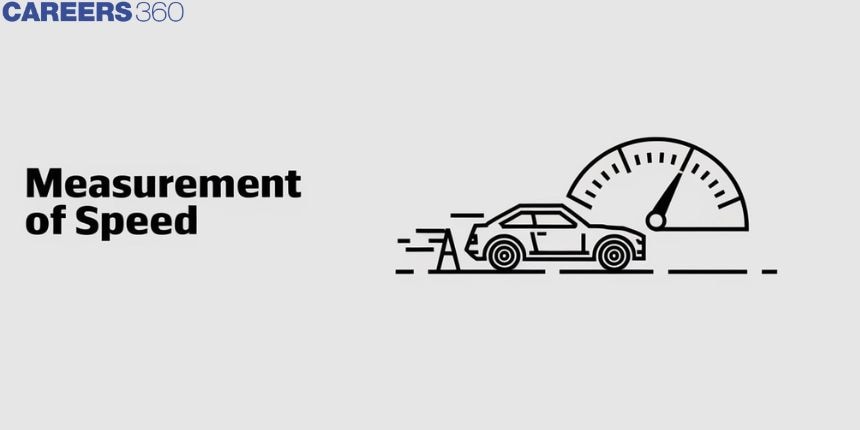Measurement of Speed - Definition, Formula, Unit, Types, FAQs
Imagine a car traveling on a road. The distance it covers in a certain amount of time tells us how fast it is moving—this is its speed. Speed is the rate at which an object moves or changes its position over time. Speed is an important phenomenon in Physics, Let's explore the concept of speed along with its calculation in detail.
This Story also Contains
- What is Speed?
- How to Calculate Speed?
- Types of Speed

What is Speed?
"The rate at which anybody moves or operates with respect to time is called the speed of the body."
In physics, the measurement of speed refers to the rate of change of position of a body with respect to time. The measurement of speed may vary according to the condition it is applied to.
The unit of speed is the meter per second ( $\mathrm{m} / \mathrm{s}$ ).
How to Calculate Speed?
Mathematically speed is represented as:
Speed $=\frac{\text { Distance }}{\text { Time }}$
Where:
- Distance is measured in meters (m) in the SI system.
- Time is measured in seconds (s) in the SI system.
Dimensional Formula for Speed
The dimensional formula for speed is:
$[$ Speed $]=[L][T]^{-1}$
Where:
- [L]: Length (meters, m)
- $[T]^{-\mathbf{1}}:$ Time inverse (seconds, $s^{-\mathbf{1}}$ )
This confirms that speed is measured in $\mathbf{m} / \mathbf{s}$ in the SI system.
Also read -
- NCERT Notes For All Subjects
- NCERT Solutions for All Subjects
- NCERT Exemplar Solutions for All Subjects
Types of Speed
- Average Speed
- Instantaneous Speed
- Uniform Speed
- Non-Uniform Speed
- Relative Speed
Average Speed
Average speed can be defined as the total distance covered divided by the total time taken.
Average Speed $=\frac{\text { Total Distance }}{\text { Total Time }}$
Example:
A car covers 100 km in 2 hours, resulting in an average speed of $\frac{\mathbf{1 0 0}}{2}=50 \mathrm{~km} / \mathrm{h}$.
Instantaneous Speed
It is the measure of speed of a body at any instant of time, or measuring the rate of change of position with respect to an infinitesimally small time period.
Instantaneous Speed $=\left|\frac{d s}{d t}\right|$
Where:
$d s$ : Infinitesimal change in distance
$d t$ : Infinitesimal change in time
Uniform Speed
Uniform speed indicates a case of motion of an object where the rate of change of position to time is constant throughout the motion, in which the object covers an equal distance in equal intervals of time.
When considering the graph it will be a straight line with a constant slope, that is if we take the slope of the graph between any two points on the graph, it will remain the same always.(we have seen what the slope in a distance vs time graph indicates, it indicates the speed)
Non-Uniform Speed
An object is said to be in non-uniform motion when there is an acceleration on the body that is the speed does not always remain the same throughout the motion, it may increase or decrease accordingly.
The rate of increase or decrease of velocity with respect to time is called acceleration, we have talked about uniform and non-uniform speed similarly there can be uniform or non-uniform acceleration also. Acceleration is a vector quantity so it cannot be mentioned in terms of speed but the magnitude of acceleration can be the rate of change of speed.
Relative Speed
The speed of one object with respect to another object is called as relative speed.
Relative Speed $=\left|v_1-v_2\right|$
Example:
If two cars are moving in opposite directions at $60 \mathrm{~km} / \mathrm{h}$ and $40 \mathrm{~km} / \mathrm{h}$, their relative speed is $60+40=100 \mathrm{~km} / \mathrm{h}$.
Frequently Asked Questions (FAQs)
Speedo meaning is rate of change of position to time and speed is a scalar quantity, it contains only magnitude and does not contain direction. Formula for speed is Speed = distance/time
If a body undergoes any kind of acceleration, then the body is said to have variable speed, that is the speed is not constant at equal intervals of time.
The example of speed or application of speed is
Speed of the vehicle
Speed of rotation of the fan
Speed of revolution of planets around sun
It means the required number of rotations per unit time such that enough water is pumped into the surface, more rotation implies more water gets pumped.
Speed is the measure of motion and it can directly imply the amount of kinetic energy possessed by the body. If a body is said to have more speed than that of the other then it implies it can cover a much higher distance in less time.